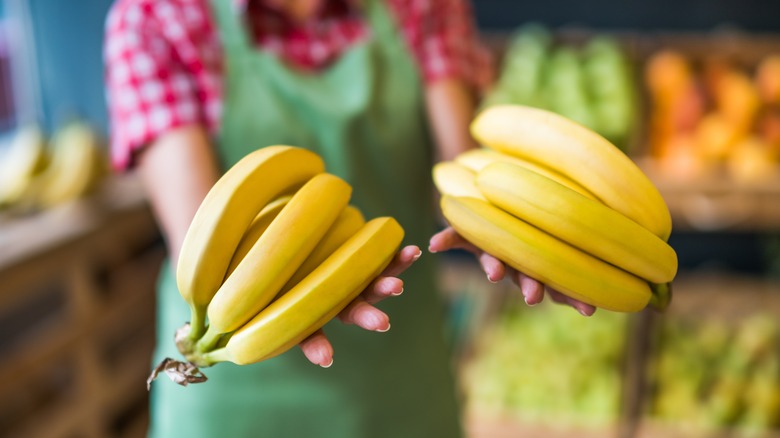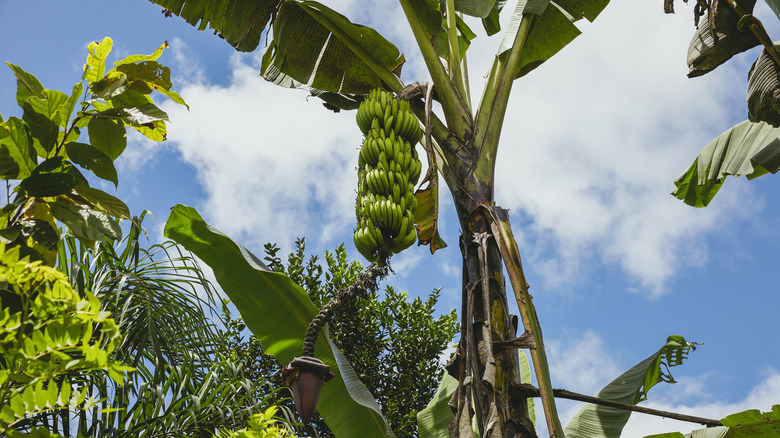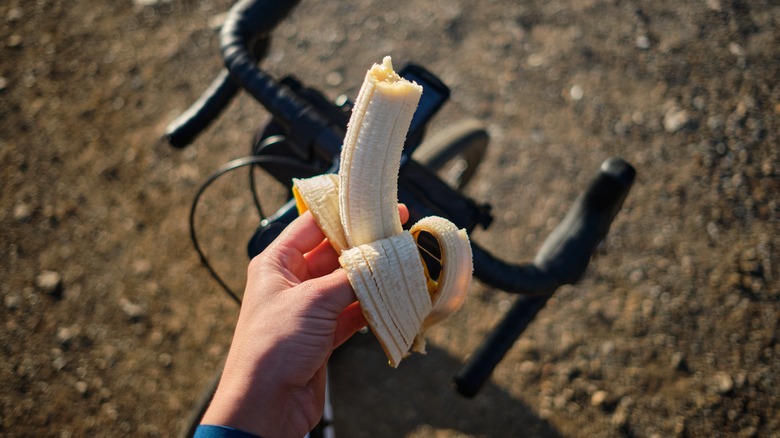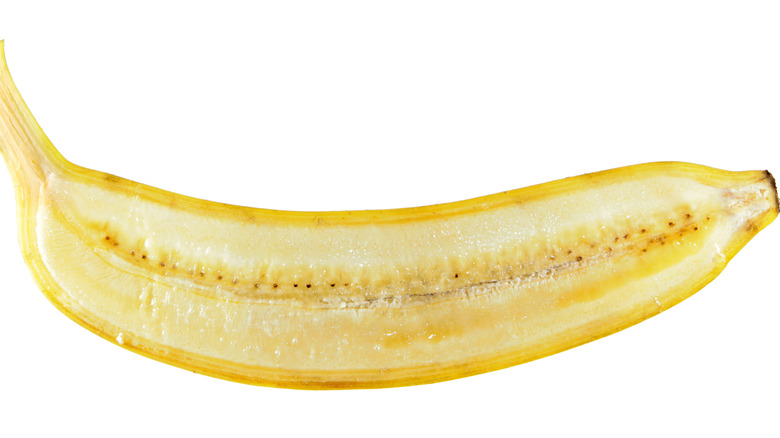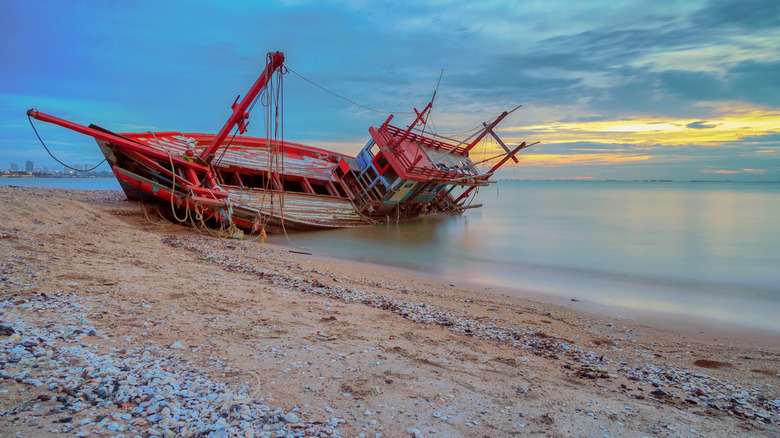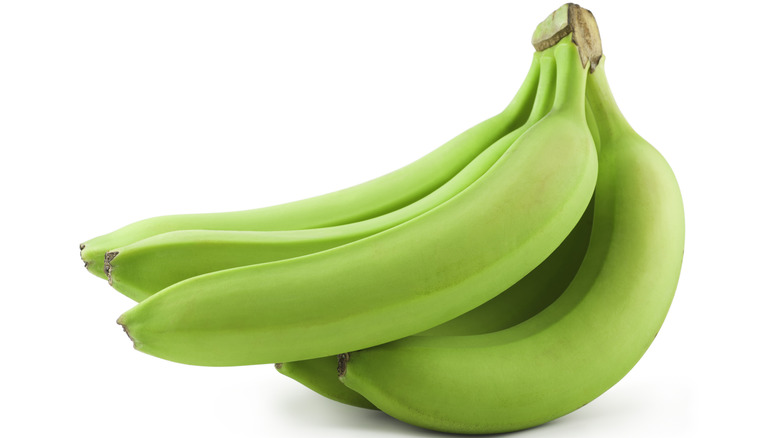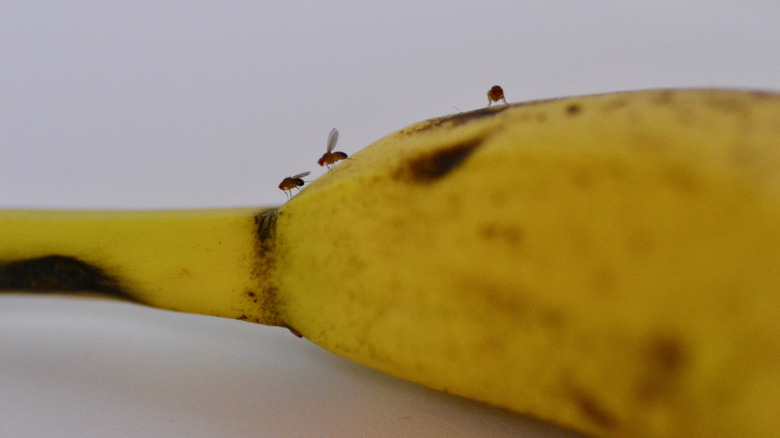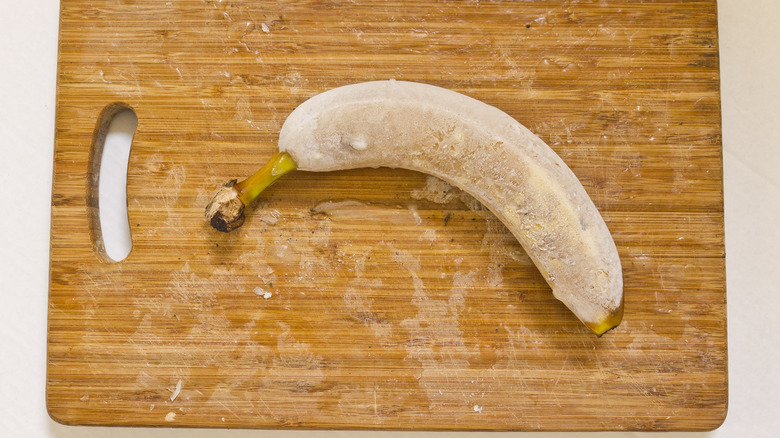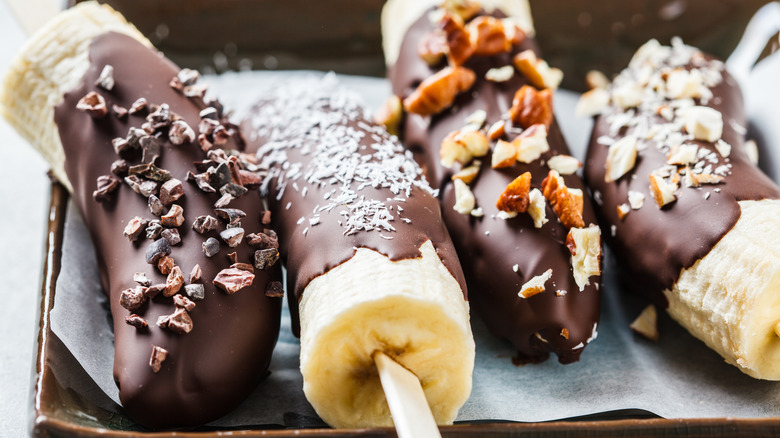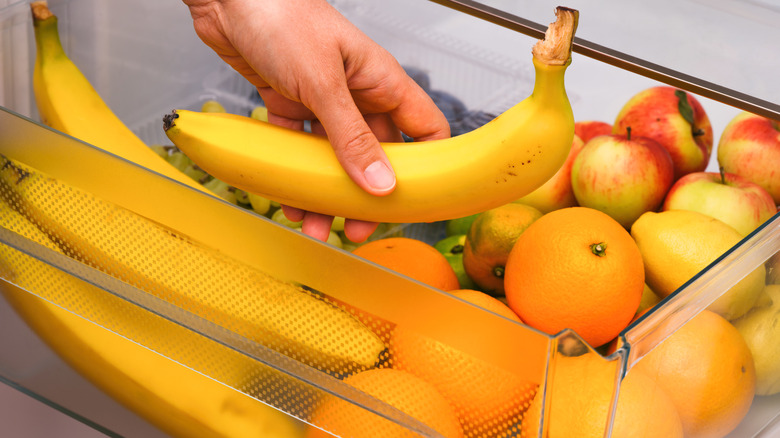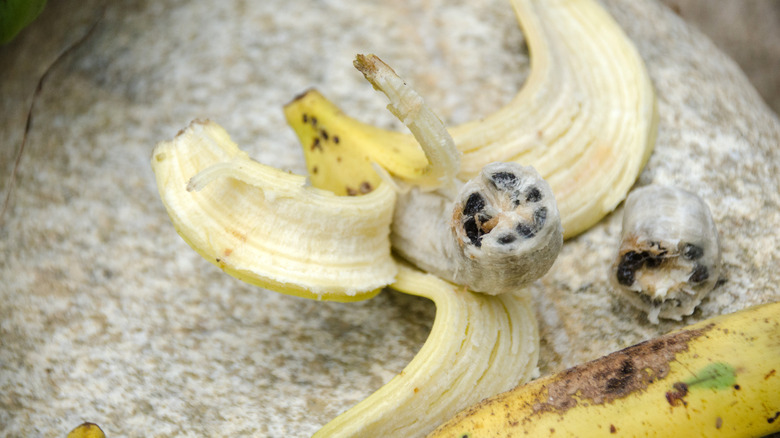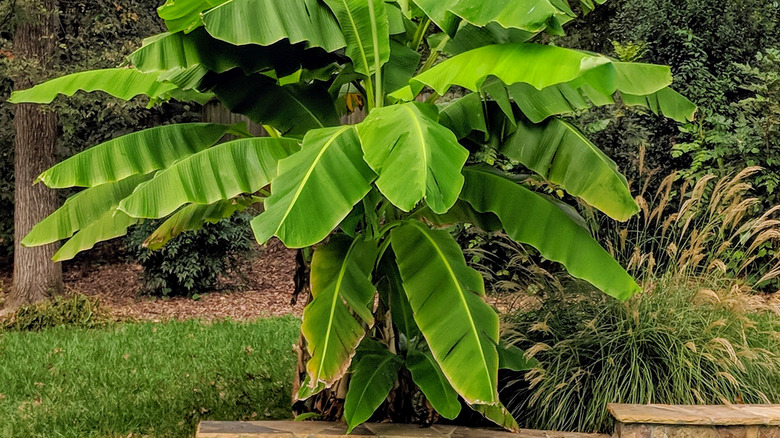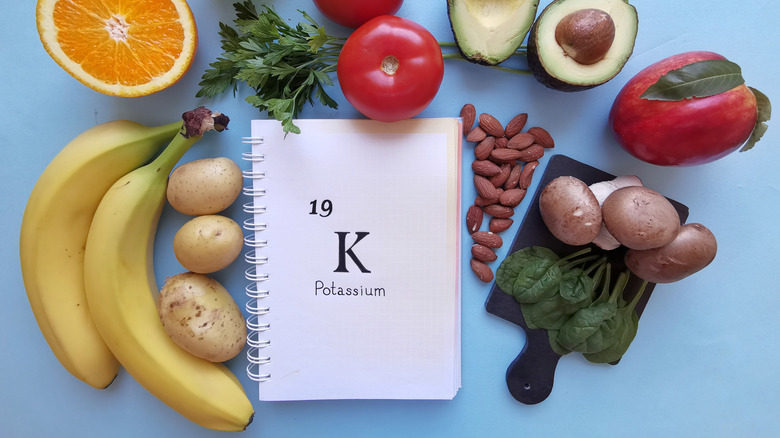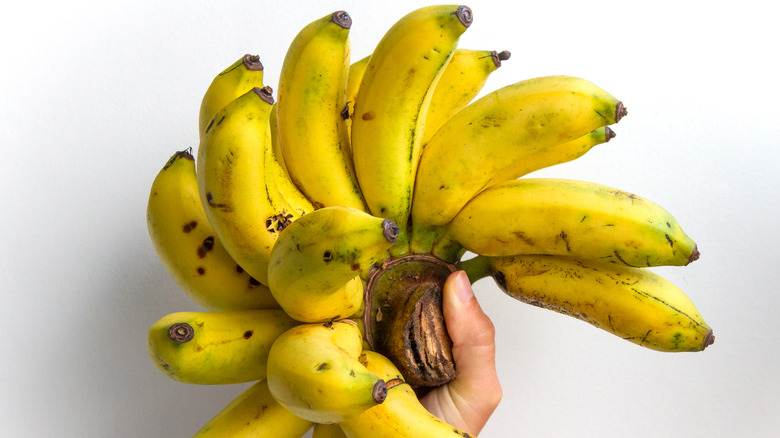13 False Facts About Bananas You Thought Were True
The banana is such a common, basic food that you wouldn't think it holds many surprises. But the reality is that it's got a long history that has led to a slew of false facts and myths that people believe to this day. In some cases, the belief in these false facts is understandable because there are seeds of truth at their core. But others are simply unsubstantiated and are only worthy of your best eyeroll.
Bananas are actually pretty interesting, from their botanical categorization to the effect they have had on seafaring sailors. They've come under fire from many different quarters for supposed dietary villainy and are often (and somewhat rightly) blamed for the sudden appearance of hordes of fruit flies in kitchens. But they're not really dietary bad guys and you can prevent those pests from invading. Meanwhile, all that history can give you some interesting banana trivia to discuss with friends. To get started busting these myths, let's take a look at these false facts about bananas you thought were true.
1. False: It's just a fruit
Bananas are treated like fruit in human diets, so they are fruits in one sense. The edible part of a banana is classified as a berry and that fact that it grows from a flower. Ultimately, you're not wrong if you name the banana as your favorite fruit.
But a banana is also arguably the product of an herb. Banana plants or trees have a succulent stem and not a woody one, such as trees do. Meanwhile, the plant is in the same taxonomic order as ginger, Zingiberales. These perennial plants can grow 15 to 20 feet tall and start from an underground corm, taking the form of one long pseudostem when above ground. The ends of the pseudostem open up to reveal a stem with a cluster of flowers (also called an inflorescence) that eventually grow into the familiar bunch of bananas. Each pseudostem lives for no more than a couple of years, often dying after just a single growing season. However, the corm can produce new pseudostems and inflorescences for years.
2. False: Bananas are unhealthy
Along with tomatoes, apples, and other fruits, bananas have gotten a bit of a bad reputation because of their sugar and carbohydrate content. While bananas admittedly aren't optimal foods for people on low-carb or keto diets, neither are they an unhealthy or fattening food at all. Bananas contain potassium and fiber, are low in calories, and the complex carbs in the fruit give you energy. You could do way worse than to snack on a banana, even if you were trying to reduce your carb intake or want to lose weight.
The only issue most people need to look out for regarding bananas, aside from eating them in moderation like any other food, concerns when to eat them. Consuming bananas right before going to bed and without brushing your teeth can lead to cavities. The soft, sticky nature of banana pulp allows it to cling to your teeth and contribute to plaque and cavity formation over time. However, that's an issue with any sweet, sticky food. Simply follow your dentist's advice and brush and floss your teeth after eating and before you go to sleep to make that a non-issue.
3. False: They're a fake food
If you want to eat nothing but "real" food that's been minimally processed, we're not going to argue with you. Given the health issues that ultra-processed foods have been linked to, this is an admirable goal. But for goodness' sake, stop calling bananas fake. There's a ridiculous claim floating around that says bananas are fake foods because they don't have seeds and that they're not nutritious as a result. Nothing could be further from the truth.
Modern cultivated bananas do indeed have seeds. They're just tiny and sterile. Bananas don't have large seeds because careful selective breeding by generations of growers has reduced the size of wild banana seeds. That's because smaller seeds leave more room for edible pulp. Moreover, the size of a fruit's seeds does not affect the nutritional content of the fruit.
Bananas have to be propagated by cutting, which does leave the species more vulnerable to disease, but it doesn't destroy nutrients. By the way, be sure you're not confusing bananas with another plant commonly known as the false banana fruit. This is an Ethiopian crop (also called enset) that's related to the banana and produces a similar-looking fruit. That fruit isn't edible, however, so the plant's fermented, cooked roots are consumed instead.
4. False: They're bad luck for fishing boats
The idea that bananas are bad luck for fishing boats is pretty old. It's mainly untrue as the supposed bad luck that led to the myth is based on real but preventable issues. Sailors long ago would get bitten by spiders hiding in banana bunches and have no medical care on board ship. These vessels would then enter port with sick or dying sailors, leading people to draw a connection between ill sailors and bananas.
Another issue was that ships would find rations spoiling easily while hauling bananas. Bananas release ethylene gas that allows other fruits and vegetables to ripen faster. However, early sailors didn't know this and some thought the bananas were just bad luck. The bananas also fermented, which created a combustible alcohol that could lead to fire — a real issue on a wooden ship. And if a ship sank, bananas in the cargo would often float, leading to an association between bananas and shipwrecks.
You can eat bananas before they ferment, keep them away from other foods, and inspect them to ensure no bitey things are hiding among a bunch. But some fishing boat companies still won't let you bring bananas on board because of personal experience. In an article for Salt Strong, one fisherman recounted the day he and two others allowed a banana on board. Equipment malfunctioned and killed all their bait fish, the weather turned unexpectedly dangerous, and their boat's bilge pump failed.
5. False: You can't eat green bananas
Many people think that, since green bananas are widely considered to be unripe bananas, they're not good to eat. That's actually not true. Bananas that are still green are safe to eat, and they may even have some interesting DND unique health benefits. For one, unripe bananas are higher in resistant starch than ripe ones. As the fruit ripens, the starch converts to sugar, which is why ripe bananas are so sweet and more likely to be used in desserts. This resistant starch is also high in fiber, and the higher pectin levels and lower sugar content of the fruit may help control blood sugar, though it may also be harder to digest, as per YMCA fitness nutrition specialist Sarah Dow.
Look out for three things if you eat green bananas. One is that the unripe fruit can be more astringent and sour. Some people have also reported digestive effects like bloating and other issues from the increased fiber and starch. And if you eat the fruit and have a tingling sensation in your mouth, you may have an allergy. This can be a latex-related allergy so, if you know you're allergic to latex, avoid bananas. It can also be a more general condition called oral allergy syndrome, where your body cross-reacts to fruit if it's also allergic to that fruit's pollen.
6. False: Bananas always equal fruit flies
Having bananas in your home does not mean you'll definitely end up swatting at fruit flies a couple of days later. While it seems the two are linked, you can prevent these invasions in two ways.
One is to wash bananas, including the stems, as soon as you bring them home. Fruit flies like to both lay eggs on the peel and hide on the fruit. It's not unusual for one to grab a ride to your place from the grocery store. The eggs are tiny, too, so when they hatch, it looks like the flies have appeared as if by magic. To prevent this, you can use a commercial fruit wash, let the fruit sit in water with a little vinegar (just a couple of spoonfuls should do), or wipe the peel with a wet paper towel as soon as you bring the fruit home.
The next preventative step is to ensure you use the fruit before it becomes overripe. Fruit flies will smell the fermenting yeasts and bacteria in the bananas, sneak inside your home, and lay eggs on the fruit. As a poster on Reddit put it, "A soft banana to them is like you walking through town and getting a whiff of BBQ from half a mile away." So, either buy only what you'll eat in a couple of days, or keep an eye on the fruit and refrigerate it when it's ripe (we'll talk more about refrigerating bananas shortly).
7. False: You can freeze bananas indefinitely
If you have bananas that you want to preserve, freezing them is a terrific idea. Unfortunately, freezing won't keep them good forever. Bananas are subject to freezer burn just like other foods and can discolor over time. If you freeze bananas, plan to use them up within three to six months for the best quality. If you store them for longer, they could still be okay to eat, but the freezer burn may affect their texture to the point of making them unappetizing in anything.
No matter how long you plan to leave bananas in the freezer, be sure to freeze them with the peel off. You may see advice to leave them unpeeled because the peel might protect the fruit from cold air, a step that then reduces discoloration and decay. But if you freeze bananas with the peel on, not only will it take longer for the fruit to thaw, but removing the peel will be difficult because thawed bananas tend to be mushy.
8. False: It's best to freeze bananas just one way
Some people say you need to freeze only whole bananas, while others may tell you to cut them up and never freeze the fruit whole. Both are wrong. You can freeze whole or cut bananas as you see fit. Choose the form based on your plans for the bananas. If you're planning to make frozen chocolate-covered bananas, for instance, cut them into the size you intend to use, such as slices or in half. If you're planning to use them in smoothies, cut them into slices or chunks. If you're planning to bake with them, freeze the fruit whole because it will be easier to find the right amount of banana to thaw. You can also mash and freeze them in specific amounts for things like pancakes.
If you're going to bake with thawed bananas, consider straining out the brownish liquid that accumulates around the pieces. When Sally's Baking Blog tested how the liquid affects a recipe by making one loaf of banana bread with a thawed banana and the liquid and one with just the thawed banana, the non-liquid loaf was lighter and rose more. The liquid-containing loaf was denser, chewier, and slower to bake.
9. False: Never refrigerate bananas
Bananas are often one of those foods that people insist you shouldn't refrigerate at all. That's simply not true. Bananas will effectively stop ripening when placed in cold temperatures (although the peel can still turn black, which is a form of chilling injury). This means you don't want to refrigerate unripe bananas that you're trying to ripen. However, once the banana reaches the stage you want, you can pop it into the fridge to make it last a few days more, so long as you don't mind the look of the darkened peel.
You can also store the banana in a cool (not cold) spot outside the refrigerator. If your kitchen tends to get warm, don't store them there unless you're going to eat them all within a day or two. Check if the interior of your cabinets stays cooler because storing bananas in the dark is also beneficial.
10. False: All bananas look the same
Both domesticated and wild bananas tend to look similar on the outside, but their insides can be very different. Wild bananas still often have an off-white pulp, but the seeds in these bananas are huge and take up most of the interior. That pulp is also very thin and not really nice to eat. Before the banana was domesticated, its edible parts were considered to be its flowers and tubers rather than the seedy fruit. Careful selective breeding by human farmers led to the soft, nearly seedless fruit many of us now find to be most familiar.
That domestication led to the creation of nearly 1,000 different banana cultivars. Researchers are still trying to figure out which species were the original wild bananas. Recent DNA analysis of wild and domesticated bananas revealed unknown DNA that implied two other banana species had been crossed with the original suspected species. Researchers want to find these ancestral bananas to help make modern bananas more resistant to the diseases that currently threaten the commercial banana industry.
11. False: You can only grow bananas in tropical climates
This one's technically false when you consider all the different types of bananas out there. Bananas are a tropical and subtropical food crop that's common in areas like Hawaii, southern California, or parts of Texas, where you can often find a banana plant or two growing in someone's backyard. Yet there is a limit to how far north you can grow edible bananas unless you have a greenhouse or resort to caring for a small container plant that you can shelter from cold weather.
But if you want to grow an ornamental banana plant in a colder region, you can do so easily, even in states you wouldn't associate with bananas. One variety, Musa basjoo (nicknamed the cold hardy banana, although its official common name is the Japanese banana), can be grown in USDA zones as cold as 4 or 5. Zone 5 is found in states like Maine and Nebraska, and zone 4 is as far north as North Dakota and even parts of southern Alaska. The USDA released a new zone map in 2023, so make sure you look at the most recent version if you plan to grow any type of banana plants.
12. False: Bananas are the best food source of potassium
You're not alone if you've ever grabbed a banana because you wanted to increase your potassium intake. Potassium is necessary for heart and muscle health as well as blood pressure regulation, yet most Americans don't get nearly enough of it in their diets (via WebMD). Bananas have a decent amount of potassium — about 9% of an adult's standard daily value, depending on the size of the banana — but they're not the best source. We're disappointed to hear that because what could be easier and faster to eat than a banana? But it turns out a lot of foods have even more potassium than bananas.
You can still eat bananas for potassium but try to get some other sources in your diet, too. One half cup of cooked white beans contains about the same amount of potassium as a banana, and you can use canned beans to speed up any recipe (they're great in salads). You'll also likely be happy to hear that white potatoes and sweet potatoes contain much potassium, although that doesn't mean you can eat a ton of fries and hashbrown patties. Instead, stick to less-processed forms like baked potatoes. Additional potassium-rich foods include avocado, leafy greens like spinach, oranges, and watermelon.
13. False: Banana flavor is based on an extinct banana
A persistent myth that people like to debate is that the overly sweet, cloying taste of artificial banana flavor is based on an older variety that's no longer sold in stores.
This is essentially false with bits of truth mixed in. What's true is that bananas stores used to sell were a very fat, flavorful variety called the Gros Michel. This variety was all but decimated by a pathogen called Fusarium oxysporum, also known as Panama disease. As a result, growers cultivated the Cavendish variety, which is the cultivar sold in most stores now. Meanwhile, the compound in bananas that gives them their distinct taste is isoamyl acetate. A manufactured version of this compound is used to give banana-flavored candy and other foods that distinct taste.
However, there's no proof that artificial banana flavor was based on the Gros Michel. Cavendish bananas have isoamyl acetate, too, after all. They just have a wider variety of chemical compounds that influence what you taste when you eat one. So, it's understandable that some people think the flavoring was based on the Gros Michel variety. But the truth is that the flavoring is just a simplified version of banana flavor.
